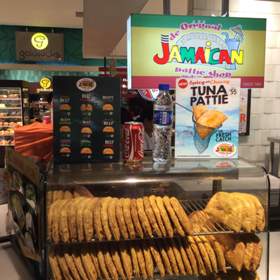Trini Abroad: My thriller in Manila

By Natalie Williams
The thing about life in Cairo is that one is well advised to take frequent breaks away. You simply have to for peace of mind, body and spirit.
Sometimes, a short trip to the Nubian oasis of Aswan or the turquoise waters of the Red Sea will do.
Most times, a complete escape from life in chaotic, buzzing, political Egypt is the best reset button.
Don’t get me wrong: after two-and-a-half years in Cairo, I still love the chaos and zany charm of Zamalek, the island in the middle of the Nile that we call home.
This Caribbean Intelligence Trini Abroad has come to co-exist harmoniously with the rhythm of my street, Hassan Sabry, and the familiar voices and faces that appear like clockwork as my neighbourhood comes alive with a myriad of sounds, sights and smells - the daily roasting of nuts, coffee and tobacco.
For me, the Muslim call to prayer led by the melodic tones of the Muezzin throughout the day is also a reminder to readjust my mind and to stop, take a deep breath, sip some tea.
By now too, I'm used to the feisty but normal way Egyptians talk to each other just under my balcony, though I'm not completely past wondering if “fight about to break out”.
And of course we never tire of seeing the great pyramids of Giza or showing off Egyptian antiquities to friends who visit, braving instability and civil unease, despite the violent revolutions, military coups and the official decision to label the Muslim Brotherhood, Egypt's oldest political grouping, a terrorist organisation.
Manila-bound
But every now and then, one needs to escape the reality of wider Cairo, which is in fact one monumental construction site with a serious garbage collection problem and scores of ugly, dusty unfinished buildings, apartment blocks and skyscrapers.
And so it was we landed in Makati, Manila, the capital of the Philippines, for a work-inspired short break. It was worth the long journey and the tedious stopover in Dubai.
Within hours of arriving, we experienced a heady familiarity about the way of life that reminded me of both the Caribbean, where I was born, and Egypt, where we are on diplomatic assignment.
The good and bad elements of life in these two regions were so evident in Manila.

Some background
Manila is the Philippines’ second largest city, one of 12 that make up Metro Manila, population 12 million.
Manila itself, with 1.7 million inhabitants, is slightly more populous than my homeland of Trinidad and Tobago (1.5 million), while Egypt has a population of 98 million, with 18 million people living in Cairo alone.
The entire Filipino population is 98.7 million, with Spanish, British, Chinese and US-influenced heritage. We could almost be describing the Caribbean mix.
And as with many Caribbean islands, the Spanish heritage is dominant in architecture, food and its citizens. It was intriguing to meet people who looked like Bruce Lee, but were named Santos Don Juan and Carlos Santana.
In essence, Makati is one massive interconnected air-conditioned shopping mall. Let's get the bad out the way.
Like Cairo, Manila is overcrowded, chaotic, polluted and suffers from horrendous traffic gridlock on its roads. Makati grinds to a halt daily and its traffic jams dominate local news headlines - daily.
So it's just as well that you can easily bail from buses, taxis and cars into cafes, bars and restaurants covering every budget.
The foodie bit
The city's saving grace is its vibrant evolving food scene.
As in Cairo, you can eat, drink, shop and explore 24 hours a day in Makati.
But, most notably, Makati is bursting at its seams with an exciting food revolution, one reason why it is fast becoming one of Asia's coolest cities.
The 7,000 islands that make up the Philippines have, in 350 years of colonial history, endured Chinese merchants, Portuguese explorers, Arab traders, Spanish conquistadors, Mexican rulers and British and American occupation.
And it really does show in its recipes and dishes. All these “foreign invaders” have added their unique ingredients and flair to the Filipino food extravaganza.
For this Trini in Egypt, Makati was foodie heaven and a burst of culinary diversity, not just on plates prepared by top chefs and cafe people, but in the variety of cuisines widely available and in its street food. It was just what our souls were craving, as Cairo lacks real diversity in its cuisine.
For starters, cold fresh coconut water was available everywhere.
Even back home in Trinidad, one has to head to a specific spot - the Queen's Park Savannah in Port of Spain - to drink coconut fresh from the hard-shelled fruit (and indeed the Trini art of opening a coconut with a machete in five seconds flat is worth the trip).
Manila has it down to a science. Coconut water glistens on ice, conveniently bottled up or fresh cut from the fruit, in every street market, supermarket and corner shop.
On the menus of most cafes, the offering was coffee, cappuccino or coconut - 'Buko' in Filipino.
Getting around
Whenever we visit a new country, one of the first things I do is coax my darling husband, the Wise One, to browse the aisles of a local supermarket - not the big foreign chain catering to expats, but the indigenous brand doing battle with the multinational.
Yes, we also patronise local museums, galleries, tourist spots and traditional landmarks, but for me, what best sets the tone of things is an inquisitive hour (or two) spent in a local supermarket, a farmers' market and a local bookshop.
These places can tell you a lot about a society and its people, even its politics and private-sector energies.
Well, the Filipino supermarket experience was unlike any I've had in a long while - and I include the superstars of London and Washington, where we have lived.
In Makati, the fish and seafood counters were almost a mile long, beautifully loaded with a variety of fresh fish, scallops, lobster, jumbo prawns, calamari and a huge array of seafood just begging to be grilled and devoured.
Browsing the bountiful aisles was joyous and left me slightly bazodee, or deranged if you believe the Wise One.
Yuh see food....
I do admit to getting carried away, gazing longingly at all the seafood on offer. Blame it on the size of the fat shrimps.
I spent a good 15 minutes trying to convince the Wise One that we could “buss a lime” in the hotel room with a kilo of scallops if we were just a little ingenious with the mini bar, the Gideon and that free box of matches they still leave in hotel rooms (despite today's no-smoking regulated world).
"No, my darling wife. We really don't need to buy a kilo of scallops, nor calamari to grill ourselves for dinner tonight. Let's just head for that Japanese restaurant we spotted in the Mall next door."
"But you love calamari and... well, look how nice and plump these scallops are, sweetie, my darling, honey bun..." was my plea.
"Yeah, but I’d rather not start a diplomatic incident by burning down a hotel in Manila with a makeshift grill, honey. No matter how you Trinis redefine ‘diplomatic immunity’."
Meat me in Manila
And then we spotted the meat counter.
The variety of pork (and chicken and beef) products left us flabbergasted.
Pork is pretty much the national meat of the Philippines and we ate hearty amounts of succulent, fork-tender dishes laced in adobo, cane juice or a citrus marinade.
There are countless recipe variations for barbecue pork alone and the country boasts four official meals of the day, with extra snacking times: 7am - 10am - 12pm - 4pm - 8pm - 11pm.
Every meal is accompanied by dozens of dipping sauces, or sawsawsans, made from ingredients such as tamarind, coconut, green mango, cane vinegar, soy sauce and citrus.
And I like a saucy dish at the best of times.
In Muslim-dominant Egypt, pork is not readily available, so I dragged my deprived taste buds away from the pork counter in Makati until the day of our departure, when a Filipino bemused butcher and I became bosom buddies as he triple-wrapped up parcels of pork loins, shoulders, chorizo sausages and pork chops, for the suitcase journey back to Cairo.
Four English words were spoken between us - "I live in Egypt" - and it was all that was needed for a mutual understanding between two strangers and for my gratitude to this young smiling butcher.
Pork adobo resembling the Guyanese pepper pot was an instant winner when we saw it on a menu, and the Filipino recipe for pork ham in a rum glaze or snapper in banana leaves could have come straight from my favourite Caribbean cookbook.
And what’s not to love about a city that revs up around food at noon every day, when red-hot charcoals are fired up in backyards and eateries, on beaches and in every hole-in-the-wall joint in Manila, for the tradition of barbecued or pit-roasted lechon/pork?
Caribbean and Phillipines
I was home: like the inhabitants of my adopted home of Egypt and my native Caribbean, Filipinos have a love affair with meat and fire.
And every day we explored Makati, its notorious road congestion provided the perfect excuse to head to a local barbecue hole for a calming bowl of steaming noodles or to savour tangy coconut pork.
Then on day two of exploring Makati, we bumped into the Jamaicans.
Freshly baked, tasty Jamaican patties with a variety of chicken, meat and fish fillings were proudly sold in Manila.
Some of these iconic parcels went in to the suitcase too.
And then one evening, at a Michelin-starred dim sum restaurant, we ate platter after platter of succulent, tamarind-laced chicken feet.
The Wise One was transported right back to days of enjoying cricket at the Queen's Park Oval in Trinidad, where chicken feet are sold as the delicacy we call strutters, which are boiled and then the liquid trumped up with pickled cucumbers, spices, garlic, onions, endless lime juice, pepper sauce and a dash of brown sugar.
From Port of Spain to Manila
Manila boasts the oldest Chinatown in Asia - crammed full of cars, people, jade products, liquor stores, scores of food places and Chinese Buddhas.
We seemed to be the only foreigners walking the alleys of Chinatown, but this didn't deter us in our hunt for what the guide books described as the best dim sum restaurant in Manila.
Although we couldn't find it and gave up at nightfall, we were more than content to go for another culinary experience.
Marvellous Manila
Every evening we witnessed nature's way of humbling a busy civilisation. You can set your watch by the rainfall in Manila, as in Trinidad.
But while in Port of Spain the welcome lunchtime showers cool things down, in Manila heavy thunderstorms unfailingly drench the after-work commuters, keeping cafes full and the place green and leafy. It rarely rains in Egypt and it shows.
So when Filipinos scowled from sidewalks and sheltered awnings, the Wise One and I were happy to kick the odd puddle and feel raindrops on our skin.
Taxis were cheaper even than in Egypt, so we were always willing to pay the fare to seek out the food spots recommended by locals and hotel staff.
Mostly, though, we contentedly walked around blissfully sampling any and every delicious morsel we were fortunate to discover in the Philippines.
Journalist and children's writer Natalie Williams has been writing for Caribbean Intelligence© about life on the move in Europe and Africa. For more from Caribbean people abroad, check out these pages.


